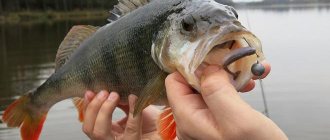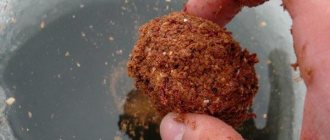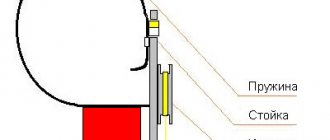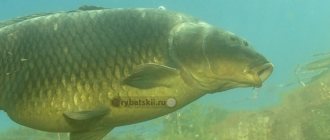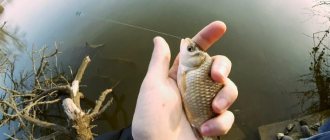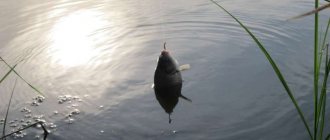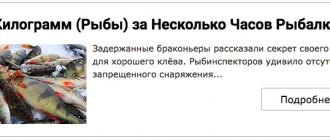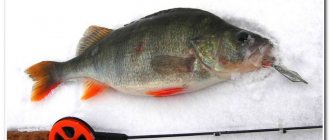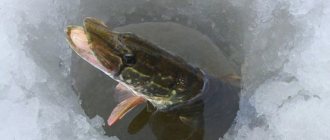When does crucian carp go to winter?
Crucians tend to change their behavioral habits with the onset of cold weather. These fish do not always go into hibernation. They spend the winter, as a rule, buried in silt and leading a sedentary lifestyle.
Whether a carp representative will lie down for the winter or spend the winter awake depends on:
- depth and area of the pond;
- bottom features;
- degree of water saturation with oxygen;
- weather conditions;
- climate of the fish farming region;
- and others.
With the onset of winter, small crucian carp tend to burrow into the bottom silt. Large individuals are less afraid of the cold. They continue to swim in the water column.
The behavior of crucian carp in the cold season largely depends on the water temperature:
- When the temperature of the aquatic environment drops to +8 ⁰С, the fish experience a slowdown in vital processes. She becomes inactive and less interested in food.
- When the water temperature is below +5 ⁰C, the respiratory rate and heart rate of crucian carp decrease several times. The fish saves energy by remaining practically motionless. She falls into a state close to anabiotic.
Is crucian carp caught in winter?
Catching crucian carp in the winter months is not easy. In one area, crucian carp are caught throughout the winter, in another they bite only during the period of ice drift or completely refuse bait. The success of crucian carp fishing in the cold season depends on the characteristics of the reservoir.
If the layer of bottom silt in the habitat of crucian carp is thin, the fish do not have favorable conditions for wintering. In such a reservoir it is caught all winter.
Karpovs can be found in:
- depressions in the muddy bottom;
- snag;
- creeks.
In the absence of oxygen deficiency, crucian carp remains active in winter. It spends the day in the depths, occasionally leaving the shelter in search of food and even swimming to shallow water.
In harsh winter conditions, the ray-finned inhabitant of fresh waters bites poorly. He is passive and has little interest in bait.
A good catch of crucian carp in winter, according to experienced fishermen, is possible on days of sharp increases in atmospheric pressure. A decrease in this environmental indicator negatively affects the behavior of the fish: it does not bite.
A good day for crucian carp fishing in the winter months meets the following requirements:
- windless;
- slightly frosty;
- solar.
Crucian carp is not caught during snowfall, blizzards, or severe frost. In such weather conditions, the fish stop feeding.
Winter habitats of crucian carp
It is no secret that during the freeze-up period the most active fish are in the current. A constant flow of water saturates the water area with oxygen and brings particles of various food. It is much more difficult to find crucian carp in the current, since it can peck when it comes out in the morning, lunchtime or even at night.

On stagnant bodies of water it is much easier to find its traces. A little knowledge about the specifics of winter fishing, the behavior of crucian carp and possible parking areas will help with solving this problem. Contrary to the belief that all fish go into pits for the winter, crucian carp should still be caught in shallow waters.
Promising areas for fishing:
- Shallow ponds and lakes. In such places the ice becomes the first to form. The older the body of water, the less likely it is to meet its inhabitants. In the relatively young water area, carp are also found in winter, which is due to the poor food supply and the absence of a dense layer of silt.
- Small river bays. At the border between calm water and the current, crucian carp are found mixed with tench. Finding working bays is difficult, but in some cases it can be done far from populated areas. If there are swamps near the river, then the chances of meeting crucian carp increase significantly.
- Old swamps flooded during the construction of reservoirs. Fish rarely leaves their favorite places, even when a large area of land is flooded. In such swamps, crucian carp can be caught for many decades, which once again confirms this theory.
- The upper reaches of ponds, gaps in reeds or cattails. One of the most promising areas is the reed wall. In winter, the vegetation withers and open windows appear. In such areas of reservoirs there is an abundant food supply, which attracts representatives of the carp family. However, you must behave carefully in shallow water so as not to scare off the local inhabitants.
Read: Fishing calendar: winter months
It is best to look for crucian carp during a thaw, since on a frosty day the fish may not show itself.
Creation of ice cover
When keeping crucian carp in a small fishing pond, it is necessary to insulate it for the winter. The construction of a protective cover made of materials will help create more favorable conditions for wintering for the carp-like inhabitants of the reservoir:
- boards;
- reed
The boards are put together to form a shield, which is then used to cover the pond.
Protection from reed stems is the best option for insulating a pond. Bundles of reeds are frozen into an ice crust. The resulting ice cover will not only protect the crucian carp from the freezing wind and frost, but will also allow air to pass through well.
Video review. Inspection of a pond for wintering crucian carp:
Crucian carp are left to spend the winter in a fishing or decorative pond (in the absence of an air compressor or pump) if it meets the following characteristics:
- the protective ice covering on the surface of the reservoir in frost is at least 0.7 m;
- layer of unfrozen water under the ice - at least 1 m;
- the depth of the reservoir in the deepest places is 6-7 m;
- pond area - 20-30 m²;
- there is a thick layer of silt at the bottom;
- the water is sufficiently saturated with oxygen.
Holes must be made in the ice crust covering the pond. The measure helps to saturate the water with oxygen, which is necessary for crucian carp for a successful winter.
Feeding
Feeding crucian carp in a home pond is not particularly problematic , since its natural diet is very varied. Over time, bloodworms and other living creatures and algae will multiply in the pond, however, for good fish growth, it requires feeding both in reservoirs with established water and in recently filled ones.
What to feed crucian carp in a home pond
Since crucian carp is omnivorous, plant foods can be used to feed it - for example, rye, bran, corn, boiled potatoes, and animal food - minced meat, bloodworms, earthworms or dung worms. For a fully balanced diet, you can also use ready-made industrially produced food . They will have an optimal ratio of nutrients and microelements - fats, fiber, proteins, vitamins. Feeding rules. The time for additional feeding of crucian carp comes when the water temperature is from 10 degrees - that is, starting from the month of April. You should not add bait earlier, because the fish will be inactive and show no interest in food. There is also an upper temperature limit, which is 25 degrees. At higher water temperatures, crucian carp also stop feeding.
Feeding process
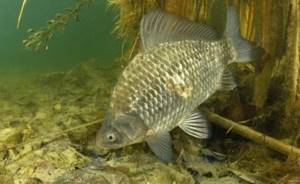
This is done so that you can regulate the process of eating food, visually monitoring the presence of bait residues at the bottom, and also in order to remove uneaten food from the water, preventing it from rotting and spoiling the water in the pond. How often and in what quantities to feed.
It is important not to exceed the volume of feed , because excess bait will be spread by crucian carp throughout the reservoir. The optimal amount of feed is calculated quite simply - the weight of a single feed should be 5% of the total weight of all crucian carp in the pond. That is, if 30 crucian carp weighing 100 g each live in a reservoir, the weight of the supplied food should be 5% of 3 kg, that is, 150 g. You can feed the crucian carp once or twice a day . It is advisable to do this at the same time, since the fish also gets used to the diet and develops a conditioned reflex.
You can even use sound stimuli before feeding, such as a bell. Thanks to the development of the reflex, the crucian carp will quickly find food lowered into the water and digest it better. Feeding time should be between 30 minutes and one hour . It is not recommended to leave excess feed in the water for a longer period.
Attention! In early spring, after waking up from hibernation, you can slightly increase the amount of food supplied to the crucian carp, since it will be actively feeding. And as the temperature approaches the upper level of the fish’s nutritional activity (25 degrees), the amount of feed must be reduced slightly.
Where to get food
You can prepare food for crucian carp yourself - for example, mix ground corn with minced meat, bone meal, and bran, steam it all with water and let it brew for about half an hour. Small balls are rolled from the finished mass, which are then fed to the fish. A good addition would be crushed leaves of dandelion, nettle or duckweed. You can also add dung worms or chopped bloodworms, which can be purchased at a pet store.
Recently, industrial food for domestic crucian carp has also become popular. The most popular manufacturers are:
- Tetra. American company producing dry fish food. This food is balanced, which allows you not to worry about the lack of any important microelements in the diet of crucian carp.
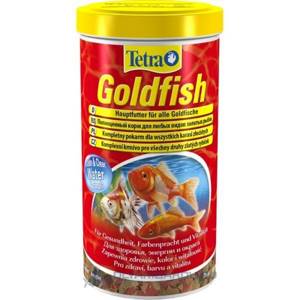
- JBL. German company producing high-quality fish food using modern equipment. The products of this company are considered one of the highest quality in the world, leaving competitors behind.
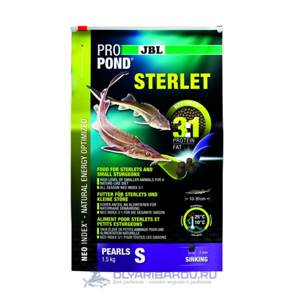
- OTTO. Produces enriched with microelements, acids and vitamins dry food that allows crucian carp to quickly reach a high weight in a home pond.
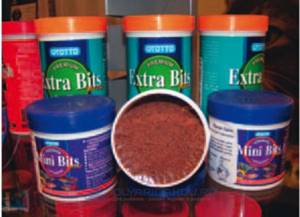
Feeding crucian fry
Ready-made food mixtures sold in pet stores are divided into several types - balanced food for adult fish, bait containing more essential microelements and vitamins and allowing for balanced nutrition, as well as food for crucian fry - for example, Tetra Pond Sticks Min i. Feed consumption should be monitored in accordance with the manufacturer's recommendations.
Attention! For feeding crucian carp, food produced for goldfish is suitable, because goldfish is a species bred in China from ordinary goldfish. There are also universal foods for most cold-loving fish.
Spawning
In order for fish to reproduce independently in a pond, it is necessary that the home pond contains the algae necessary for spawning. Also, to fertilize the eggs, it is necessary that there are male goldfish in the reservoir.
Attention! To regulate the number of crucian carp and its size during independent reproduction in a home pond, you need to throw a small pike into it - about 20-30 cm long. It will eat small individuals, preventing overpopulation of the reservoir and leaving larger fish.
Crucian carp spawning
Crucian carp in a home pond in winter
leave fish for the winter only in those ponds in which the thickness of unfrozen water in the most severe winter frosts should be at least 70 cm . For the winter, crucian carp will burrow into the silt , showing minimal activity. The main task at this time remains maintaining the required oxygen concentration in the water. To do this, you can use specialized equipment or regularly make ice holes. To make them freeze more slowly, you can insert tree branches or tufts of grass into them.
How fast it grows
In two years, with proper feeding, silver crucian carp from fry can grow to 250 - 300 g. Golden crucian carp has a slightly smaller increase in one year, but over time it grows to large sizes.
Peculiarities of fish behavior under ice
With the arrival of winter, crucian carp are still quite active. They often experience gluttony when there is first ice. In the dead of winter, the fish becomes passive. It moves sluggishly in places where the oxygen regime is stable and food is available.
The behavior of crucian carp during wintering in different climatic zones varies:
- In bodies of water with warm water. Where the water does not freeze in the cold months, crucian carp are active all year round and do not hibernate. This behavior in winter is typical of fish living in deep-water ponds in areas with a mild climate.
- In northern regions with harsh climates. In such regions, crucian carp tend to go to winter, burying themselves in bottom sediments, and spend the cold season sleeping.
- In moderate winter conditions. A carp-like inhabitant of fresh waters is looking for a suitable wintering hole with warm water. He sleeps there for most of the day, periodically leaving his hiding place in search of prey.
The worst conditions for wintering of the carp-like inhabitant of fresh waters are observed in water bodies that freeze in winter and lack a thick bottom layer of silt.
The crucian carp's habit of sinking to the bottom for the winter is due not only to the need to look for a warmer place in the reservoir, but also to the need to obtain food for itself. In the cold season, when fish are inactive, they prefer animal food. Crucian carp obtain bloodworms and larvae by burrowing in bottom sediments.
Fishing tactics
When catching crucian carp with a jig, you can use passive and active fishing techniques. With the passive method of fishing, you simply lower the jig to the bottom and wait for a bite. The active method of fishing involves moving the jig with a certain frequency.
To lure crucian carp from the bottom, fishermen often use the tactic of playing with a jig, which is lowered to the depths. In winter, crucian carp can play with the bait for 5-10 minutes, so there is no need to rush, so as not to make empty hooks. The thinner and more delicate the tackle, the easier it will be to hook a fish that is baiting the bait.
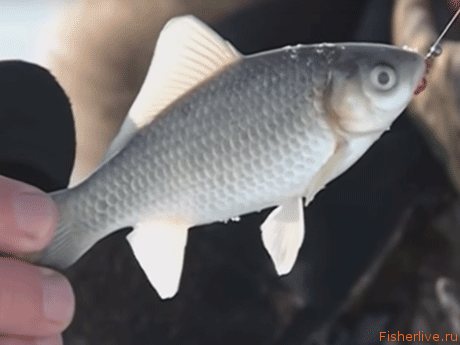
You should also learn how to move the rod correctly, making pauses that attract the attention of the crucian carp. The attention of this fish can be attracted both by a stationary rod and by playing with a jig, developing your own tactics for winter fishing for crucian carp.
Fish in the water feel every movement well, so a moving bait quickly attracts its attention. In order to more successfully control a jig submerged in water, it is necessary to balance its weight with a float.
The jig should be moved smoothly near the bottom, raising and lowering it back to the bottom each time. In this case, pauses should be made so that the constantly moving bait does not frighten the fish. The fish may not pay any attention to a stationary jig at all.
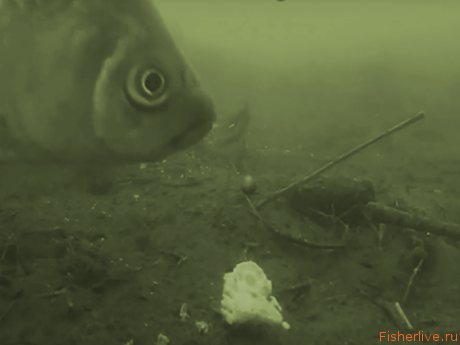
It is advisable to move the rod with maximum ease and accuracy; be sure to pause to attract the crucian carp in order to arouse interest with all the elements of intrigue. The fish's attention can be directed both to the stationary tackle and to the game itself, so you need to find a middle ground.
Developing the right fishing tactics will activate the fish and ensure a stable good bite.
What problems may arise in connection with the wintering of crucian carp?
When keeping crucian carp in a fishing or decorative pond during the cold season, difficulties arise if:
- Sick fish were sent for the winter. Sick, injured, or parasite-infested fish have little chance of surviving the winter cold. Only healthy fish will survive until spring.
- The sanitary condition of the pond is insufficient. That is, the reservoir is swampy, silted, overgrown with algae, and clogged with food debris. Wintering crucian carp in such conditions is difficult. If the water in the reservoir is not drained for the winter, cleaning and preparatory work is carried out before winter so that the oxygen needed by the fish is not consumed during the decomposition of organic matter.
- The fish remained on pasture for the winter. The crucian carp will not gain weight, it will become thin. It is prepared for wintering in the fall. All cyprinids are switched to protein feed. In a reservoir with an area of 50 m², no more than 1/2 kg of fish is kept on natural food. The large number of crucian carp in the pond requires increased nutrition before wintering to gain weight.
- Too cold. The water temperature is reduced to +2-3 ⁰С at a shallow depth of the reservoir. This poses a danger to young individuals. They are susceptible to cold burns on the body and gills. Injured fish will not survive until spring.
The problem of low oxygen content in water and ways to eliminate it
The most common mistake when wintering crucian carp in an artificial pond is that the pond is completely covered with ice. In this case, there is a detrimental lack of air for the fish.
Photosynthesis is absent in winter and does not affect the balance of oxygen in water. The supply of oxygen in winter occurs only due to contact of the water surface with air.
The following will help to avoid the problem of low oxygen concentration in the aquatic environment:
- violation of the integrity of the ice crust covering the reservoir by creating and maintaining an ice-free polynya;
- making a hole in the ice and then pumping out 20 cm of water.
In order for crucian carp to have the opportunity to breathe freely under the ice in winter, they should live in a sufficiently deep and large decorative fishing pond (deep places up to 6-7 m, area - 20-30 m²).
Keeping cyprinids in a shallow pond (from 0.8 m) is only possible with special equipment, such as electric water pumps and air compressors.
Video instruction. Aerating a fishing pond by installing a compressor:
In the absence of electrical equipment, you cannot do without holes in the ice cover of the pond. They are drilled, not pierced, using a hammer for this purpose. Otherwise, there is a risk of injury to the inhabitants of the reservoir by the shock wave.
It is also possible to make a hole using a pan filled with boiling water. It is simply placed on ice and left for a while to melt it.
Baits and lures
For a good catch of crucian carp in winter, avid fishermen not only use long-proven baits, but also experiment with new products. The attachment can be different, but the most popular are traditional bloodworms and dung or earthworms.
It is customary to attach 2-3 amber bloodworm larvae to the hook , which is a winning option among other baits. Crucian carp itself is a rather finicky type of fish regarding bait, so the larvae must be updated periodically. Earthworms are harvested in the fall.
Reserve bait is also suitable : regular bread, well-steamed pearl barley, semolina, lard, oatmeal, dough and much more. As for the flour dough, there is a small nuance: for ease of use, it can be inserted into a disposable syringe, and then squeezed out a little as needed. This container option is very relevant and has its advantages: the dough does not freeze, does not stick to your hands, and does not stain clothes.
To lure crucian carp, each fisherman has his own specially made baits in his arsenal, the recipes of which are carefully hidden from others. However, there is a standard, proven method that is most often used by experienced anglers: a small amount of maggots, crushed worms and small bloodworms are added to the mixture of breadcrumbs.
There are also some subtleties here ; everything is not so prosaic. If the bait consists mostly of animal bait, this may attract unwanted guests: ruff and perch. Seeing such competitors, crucian carp will not approach the places where food is located.
In stores specializing in fishing tackle, baits are presented in a fairly wide assortment for every taste and color.
It should be noted that complementary food for crucian carp in winter should be meager. Pieces of the mixture no larger than a chicken egg are thrown into the hole (1-2 pieces are enough) before starting fishing. When soaking complementary foods, it is recommended to take into account the required amount of water so that the lowered balls systematically sink to the bottom, splitting along the way.
The effect of the bait occurs gradually, so it is more advisable to treat the desired area over several days. There is a practice of catching crucian carp in winter without using any additional food at all, but from experience it is clear that such fishing really comes down to a lottery.
Since each body of water has its own characteristics, and the behavior of crucian carp in different conditions is unique, it is worth listening to your intuition and gaining your own experience for successful trips for this fish.
Interesting to know
Common crucian carp have a hard time in winter in reservoirs that freeze to the very bottom. The fish is in no hurry to burrow into the mud: there is no oxygen there. Compared to its counterpart, which is bred in an artificial pond for commercial purposes, wintering of crucian carp in its natural habitat is often extreme.
At low air temperatures, a small, stagnant pond or shallow lake freezes completely. Under the current conditions, the crucian carp lies on the bottom and falls into an anabiotic state until the heat returns.
Often the ray-finned inhabitant ends up frozen into the ice and dies. It is noteworthy that some individuals come to life after such an extreme wintering.
The difference between the winter lifestyle of this representative of the Cypriniformes order and other fish species is its lower mobility. Throughout the freeze-up period, crucian carp stick to deep places in the reservoir. Its concentration is especially high in the so-called wintering pits.
Their larger and more active relatives, carp, often spend the winter months next to crucian carp.
Breeding crucian carp requires proper preparation of the place where it is kept in winter. Approach this preparation carefully and carefully. Creating optimal conditions for fish in winter is the key to successful wintering of crucian carp without large losses.
0
0
Copy link
How to catch crucian carp in winter and prepare the tackle
Fishing for crucian carp in winter from ice is not that difficult in terms of assembling and equipping suitable equipment. Even for a powerful carp trophy of 300–500 grams, it is enough to assemble a small-sized winter fishing rod. The equipment must include all the attributes for winter fishing - a nod that is sensitive to the jig used, a monofilament line that is optimal in terms of breaking parameters, a reel or an inertial reel for storing line. Delicate and thin gear will be significant in terms of the number of catches and the number of bites sold. Sensitive to rough equipment, cautious and suspicious in winter, fish take jigs better from neat and inconspicuous rigs.
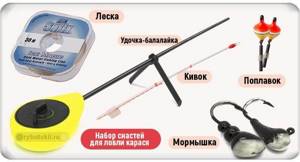
Elements of winter fishing rod tackle
Two tackle options
Tackle for crucian carp in winter is collected on a light foam balalaika fishing rod. This type of fishing rod effectively produces a fine, low-amplitude game with jigs and more clearly feels a gentle, careful bite. 10–15 meters of monofilament fishing line are placed in the fishing rod cache for winter fishing conditions. The thickness of the monofilament is selected in the range from 0.08 to 0.12 mm. The thinner the line, the more distinct the action of the bait, the more delicate and inconspicuous the equipment for fish that are suspicious of every little thing.
The tackle can be without a float, and the bite can be tracked by the nod.
Often crucian carp tackle is formed on larger fishing rods designed for trolling perch. On such gear, long sensitive nods are installed, with the help of which they detect bites and produce the game of the jig necessary for the fishing conditions, more carefully controlling its wiring in the required mode.
In both cases, having caught the prey that has pecked, they in no way force the landing of the fish. Thin fishing lines provide advantages in creating delicacy and high sensitivity of the equipment, but at the final stage of fishing for the caught trophy, all the efforts of the fisherman will be nullified by a simple break of the cord. Therefore, a small hook at the hole will be useful, which will help in catching powerful crucian carp.
Fishing technique for each gear
There are several strategies for crucian carp fishing, the choice of which directly depends on the activity of the fish. Tackle of any design (this is especially practiced when prey is actively feeding) is set motionless and awaiting a bite. The essence of this strategy is the principle of attracting crucian carp with a richly attached bloodworm to a jig laid on the bottom. You can make unobtrusive and slow plays with a jig - these should be light and small vibrations with long pauses.
Basically, crucian carp bite carefully in winter and there is no need to rush into hooking.
Crucian carp is also caught by periodically raising the bait ten centimeters from the bottom with a reverse descent of the jig to attract the fish by moving the nozzle. You can occasionally make short oscillations of the jig with a small amplitude of play. This way the fish will react faster to the bait given to it.
Remember that too active play will have a negative impact on the bite . Do not forget that winter is not the best period for heat-loving crucian carp and you should not try too hard to attract its attention. Be that as it may, in cold water the crucian carp is slowed down and the speed of the bait’s movements is more likely to scare away the fish than to entice it to bite. Ice fishing for crucian carp will require careful movements and restlessness in fishing.
